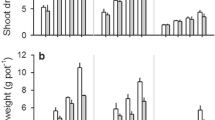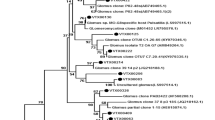Abstract
Aims
This study evaluated the responses to and recovery from soil waterlogging, soil salinity and the combination of these stresses of the annual pasture legumes Melilotus siculus cv. Neptune, Trifolium michelianum cv. Frontier and Medicago polymorpha cv. Scimitar. The major aim was to test the tolerance of these plants to salinity and waterlogging in soil inoculated with rhizobia, adding to previous controlled-environment studies, which have used nutrient solution cultures, as well as to examine post-stress recovery.
Methods
Plants were grown in pots of soil inoculated with their appropriate species-specific rhizobia. Drained non-saline controls, and waterlogged non-saline, drained saline (100 mM NaCl) and waterlogged saline treatments were imposed for 3 weeks, followed by a 4 week recovery period.
Results
In the waterlogged saline soil, shoot dry mass of M. siculus was 63% of the control, compared to 10% for T. michelianum and 5% for M. polymorpha, and after the recovery phase was 75% of the control for M. siculus, 58% for T. michelianum and 4% for M. polymorpha. Foliar Na+ concentrations of T. michelianum and M. polymorpha were 2.8-fold higher than for M. siculus.
Conclusions
The greater tolerance of M. siculus can be attributed to regulation of leaf Na+ concentrations in saline conditions and the formation of aerenchymatous phellem to enhance O2 supply to roots in waterlogged soils. This controlled glasshouse study using pots of soil supports earlier nutrient solution experiments and field observations that M. siculus possesses greater tolerance of combined waterlogging and salinity, than T. michelianum and M. polymorpha.





Similar content being viewed by others
References
Anschütz U, Becker D, Shabala S (2014) Going beyond nutrition: regulation of potassium homoeostasis as a common denominator of plant adaptive responses to environment. J Plant Physiol 171:670–687
Armstrong W (1979) Aeration in higher plants. Adv Bot Res 7:225–332
Arnell N, Liu C (2001) Climate Change 2001: hydrology and water resources. Report from the Intergovernmental Panel on Climate Change. http://www.ipcc.ch/. Accessed 18 July
Barrett-Lennard EG (2003) The interaction between waterlogging and salinity in higher plants: causes, consequences and implications. Plant Soil 253:35–54
Barrett-Lennard EG, Shabala S (2013) The waterlogging/salinity interaction in higher plants revisited – focusing on the hypoxia induced disturbance to K+ homeostasis. Funct Plant Biol 40:872–882
Bonython AL, Ballard RA, Charman A, Nichols PGH, Craig AD (2011) New strains of rhizobia that nodulate regenerating Messina (Melilotus siculus) plants in saline soils. Crop and Pasture Science 62:427–436
Craig AD, Sandral GA, Dear BS, Latta RA, Evans PM, Hill NL (2000) Register of Australian herbage plant cultivars. B. Legumes. 1. Clover. Trifolium michelianum Savi (balansa clover) cv. Frontier. Aust J Exp Agric 40:1201–1022
DPIRD (2019) Neptune messina – a new pasture legume for saline soils prone to waterlogging, Department of Primary Industries and Regional Development. http://www.agric.wa.gov.au/neptune. Accessed 6 Aug 2019
Drew MC, Läuchli A (1985) Oxygen-dependent exclusion of sodium ions from shoots by roots of Zea mays (cv Pioneer 3906) in relation to salinity damage. Plant Physiol 79:171–176
Drew MC, Guenther J, Läuchli A (1988) The combined effects of salinity and root anoxia on growth and net Na+ and K+ − accumulation in Zea mays grown in solution culture. Ann Bot 61:41–53
Elzenga JTM, van Veen H (2010) Waterlogging and plant nutrient uptake. In: Mancuso S, S Shabala S (eds) waterlogging signalling and tolerance in plants. Springer, Heidelberg, pp. 23–35
Falakboland Z, Zhou M, Zeng F, Kiani-Pouya A, Shabala L, Shabala S (2017) Plant ionic relation and whole-plant physiological responses to waterlogging, salinity and their combination in barley. Funct Plant Biol 44:941–953
Greenway H, Munns R (1980) Mechanisms of salt tolerance in nonhalophytes. Annu Rev Plant Physiol 31:149–190
Hamblin J, Barbetti MJ, Stefanova K, Blakeway F, Clements J, Cowling W, Guo Y, Nichols P (2018) Crop breeding to break nexus between bee decline/food production? Global Food Security 19:56–63
Hanley ME, Gove TL, Cawthray GR, Colmer TD (2017) Differential responses of three coastal grasland species to seawater flooding. J Plant Ecol 10:322–330
Hunt R (1982) Plant growth curves. The functional approach to plant growth analysis. Edward Arnold Ltd., London
Konnerup D, Toro G, Pedersen O, Colmer TD (2018) Waterlogging tolerance, tissue nitrogen and oxygen transport in the forage legume Melilotus siculus: a comparison of nodulated and nitrate-fed plants. Ann Bot 121:699–709
Kotula L, Khan HA, Quealy J, Turner NC, Vadez V, Siddique KHM, Clode PL, Colmer TD (2015) Salt sensitivity in chickpea (Cicer arietinum L.): ions in reproductive tissues and yield components in contrasting genotypes. Plant Cell Environ 38:1565–1577
Kotula L, Clode PL, Jimenez JDLC, Colmer TD (2019) Salinity tolerance in chickpea is associated with the ability to ‘exclude’ Na from leaf mesophyll cells. J Exp Bot. https://doi.org/10.1093/jxb/erz241
Maathuis FJ, Amtmann A (1999) K+ nutrition and Na+ toxicity: the basis of cellular K+/Na+ ratios. Ann Bot 84:123–133
Malik AI, Colmer TD, Lambers H, Setter TL, Schortemeyer M (2002) Short-term waterlogging has long-term effects on the growth and physiology of wheat. New Phytol 153:225–236
Malik AI, English JP, Comer TD (2009) Tolerance of Hordeum marinum accessions to O2 deficiency, salinity and these stresses combined. Ann Bot 103:237–248
Marañon T, Garcia LV, Troncoso A (1989) Salinity and germination of annual Melilotus from the Guadalquivir delta (SW Spain). Plant Soil 119:223–228
Munns R, Tester M (2008) Mechanisms of salinity tolerance. Annu Rev Plant Biol 59:651–681
Munns R, Wallace PA, Teakle NL, Colmer TD (2010) Measuring soluble ion concentrations (Na+, K+, cl−) in salt-treated plants - chapter 23. In: Sunkar R (ed) plant stress tolerance: methods and protocols. Humana Press, New York, pp 371–382
National Land and Water Resources Audit (2001) Australian dryland salinity assessment 2000. Extent, impacts, processes, monitoring and management options. National Land and Water Resources Audit, Canberra, Australia
Nichols PGH, Loi A, Nutt BJ, Evans PM, Craig AD, Pengelly BC, Dear BS, Lloyd DL, Revell CK, Nair RM, Ewing MA, Howieson JG, Auricht GA, Howie JH, Sandral GA, Carr SJ, de Koning CT, Hackney BF, Crocker GJ, Snowball R, Hughes SJ, Hall EJ, Foster KJ, Skinner PW, Barbetti MJ, You MP (2007) New annual and short-lived perennial pasture legumes for Australian agriculture – 15 years of revolution. Field Crop Res 104:10–23
Nichols PGH, Rogers ME, Craig AD, Albertson TO, Miller SM, McClements DR, Hughes SJ, D’Antuono MF, Dear BS (2008) Production and persistence of annual pasture legumes at five saline sites in southern Australia. Aust J Agric Res 48:518–535
Nichols PGH, Malik AI, Stockdale M, Colmer TD (2009) Salt tolerance and avoidance mechanisms at germination of annual pasture legumes: importance for adaptation to saline environments. Plant Soil 315:241–255
Nichols PGH, Revell CK, Humphries AW, Howie JH, Hall EJ, Sandral GA, Ghamkhar K, Harris CA (2012) Temperate pasture legumes in Australia – their history, current use and future prospects. Crop and Pasture Science 63:691–725
Nichols PGH, Ballard RA, Pearce AL, Wintle BJ, Craig AD (2019) ‘Neptune’, the world’s first Messina (Melilotus siculus) cultivar: an annual pasture legume for saline soils prone to winter waterlogging. In: Proceeding of the 19th Australian agronomy conference, 25–29 august, 2019, Wagga Wagga, NSW, Australian agronomy society (in press)
Pate JS, Dart PJ (1961) Nodulation studies in legumes. Plant Soil 15:329–246
PBR database (2019) Plant breeders rights database. IP Australia, Commonwealth Government of Australia. Available at: http://pericles.ipaustralia.gov.au/pbr_db/. Accessed 6 Aug 2019
Ponnamperuma FN (1984) Effects of flooding on soils. In: Kozlowski TT (ed) flooding and plant growth. Academic Press, New York, pp 9–45
Porqueddu C, Ates S, Louhaichi M, Kyriazopoulos AP, Moreno G, del Pozo A, Ovalle C, Ewing MA, Nichols PGH (2016) Grasslands in ‘Old World’ and ‘New World’ Mediterranean climate zones: past trends, current status and future research priorities. Grass Forage Sci 71:1–35
Puckridge DW, French RJ (1983) The annual legume pasture in cereal – ley farming systems of southern Australia: a review. Agric Ecosyst Environ 9:229–267
Rochon JJ, Doyle CJ, Greef JM, Hopkins A, Molle G, Sitzia M, Scholefield D, Smith CJ (2004) Grazing legumes in Europe: a review of their status, management, benefits, research needs and future prospects. Grass Forage Sci 59:197–214
Rogers ME, Noble CL (1991) The effect of NaCl on the establishment and growth of balansa clover (Trifolium michelianum Savi. Var. balansae Boiss.). Aust J Exp Agric 42:301–329
Rogers ME, West DW (1993) The effects of rootzone salinity and hypoxia on shoot and root growth in Trifolium species. Ann Bot 72:503–509
Rogers ME, Colmer TD, Frost K, Henry D, Cornwall D, Hulm E, Deretic J, Hughes SR, Craig AD (2008) Diversity in the genus Melilotus for tolerance to salinity and waterlogging. Plant Soil 304:89–101
Rogers ME, Colmer TD, Nichols PGH, Hughes SJ, Frost K, Cornwall D, Chandra S, Miller SM, Craig AD (2011) Salinity and waterlogging tolerance amongst accessions of Messina (Melilotus siculus). Crop & Pasture Science 62:225–235
Setter TL, Waters I (2003) Review of prospects for germplasm improvement for waterlogging tolerance in wheat, barley and oats. Plant Soil 253:1–34
Striker GG (2012) Time is on our side: the importance of considering a recovery period when assessing flooding tolerance in plants. Ecol Res 27:983–987
Striker GG, Colmer TD (2016) Flooding tolerance of forage legumes. J Exp Bot 68:1851–1872
Striker GS, Teakle NL, Colmer TD, Barrett-Lennard EG (2015) Growth responses of Melilotus siculus accessions to combined salinity and root-zone hypoxia are correlated with differences in tissue ion concentrations and not differences in root aeration. Environ Exp Bot 109:89–98
Teakle NL, Real D, Colmer TD (2006) Growth and ion relations in response to combined salinityand waterlogging in the perennial forage legumes Lotus corniculatus and Lotus tenuis. Plant Soil 289:369–383
Teakle NL, Armstrong J, Barrett-Lennard EG, Colmer TD (2011) Aerenchymatous phellem in hypocotyl and roots enables O2 transport in Melilotus siculus. New Phytol 190:340–350
Teakle NL, Bowman S, Barrett-Lennard EG, Real D, Colmer TD (2012) Comparisons of annual pasture legumes in growth, ion regulation and root porosity demonstrate that Melilotus siculus has exceptional tolerance to combinations of salinity and waterlogging. Environ Exp Bot 77:175–184
Yates RJ, Abaidoo R, Howieson JG (2016) In: Howieson JG, Dilworth MJ (eds) Working with rhizobiaField experiments with rhizobia. Australian Centre for International Agricultural Research, Canberra, pp 145–166
Acknowledgements
L.K. was supported by the ARC Industrial Research Hub for Legumes for Sustainable Agriculture (Australian Research Council IH140100013 in partnership with the Grains Research and Development Corporation) at the UWA node with T.D.C. P.N. conducted this research while employed with the Department of Primary Industries and Regional Development.
Author information
Authors and Affiliations
Corresponding author
Additional information
Responsible Editor: Eric J.W. Visser.
Publisher’s note
Springer Nature remains neutral with regard to jurisdictional claims in published maps and institutional affiliations.
Electronic supplementary material
ESM 1
(DOCX 336 kb)
Rights and permissions
About this article
Cite this article
Kotula, L., Kwa, H.Y., Nichols, P.G.H. et al. Tolerance and recovery of the annual pasture legumes Melilotus siculus, Trifolium michelianum and Medicago polymorpha to soil salinity, soil waterlogging and the combination of these stresses. Plant Soil 444, 267–280 (2019). https://doi.org/10.1007/s11104-019-04254-z
Received:
Accepted:
Published:
Issue Date:
DOI: https://doi.org/10.1007/s11104-019-04254-z




